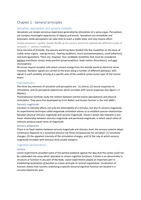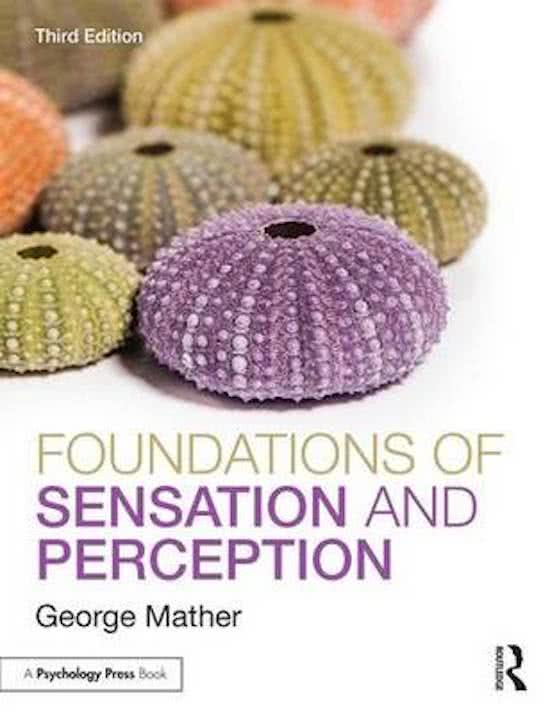Chapter 1 : General principles
Sensation, perception, and sensory modality
Sensations are simple conscious experience generated by stimulation of a sense organ. Perceptions
are complex meaningful experiences of objects and events. Sensations are immediate and
automatic, while perceptions can take time to reach a stable state, and may require effort.
Simple sensations = qualia. Qualia divide up the sensory world into qualitatively different modes of
sensation <-- sensory modalities.
Since the time of Aristotle, the sensory world has been divided into five modalities on the basis of
visible sense organs : seeing (vision) , hearing (audition), touch (somatosensation), smell (olfaction),
and taste (gustation). There are, however, four candidate modalities that must be considered :
balance (vestibular sense), body position (proprioception), body motion (kinesthesis), and pain
(nociception).
All senses require receptor cells which convert energy from the outside world to electrical nerve
impulses. Receptor signals are carried to the brain along a number of different pathways, with
signals in each modality arriving at a specific area of the cerebral cortex (outer layer of the human
brain).
Psychophysics
The three key elements of sensation and perception are : (1) stimuli, (2) neural responses to
stimulation, and (3) perceptual experiences which correlate with neural responses (see figure 1.3
Mather).
Psychophysical methods study the relation between mental events (perceptions) and physical
stimulation. They were first developed by Ernst Weber and Gustav Fechner in the mid-1800’s.
Sensory magnitude
Variation in intensity affects not only the detectability of a stimulus, but also its sensory magnitude.
An experimental technique called magnitude estimation allows us to establish precise relationships
between physical stimulus magnitude and sensory magnitude. Steven’s power law indicates a non-
linear relationship between stimulus magnitude and perceived magnitude, in which equal ratios of
intensity produce equal ratios of magnitude.
Sensory adaptation
There is no fixed relation between sensory magnitude and stimulus level, the sensory systems adapt.
Continuous exposure to a sustained stimulus has three consequences for sensation: (1) sensitivity
changes, (2) the apparent intensity of the stimulation changes, and (3) the rate at which sensory
magnitude increases with stimulus level usually steepens.
Cognitive neuroscience
Lesions
Lesion experiments provided some of the earliest evidence against the idea that the cortex could not
be subdivided into areas which specialize in certain cognitive functions. A lesion is an abnormality in
structure or function in any part of the body. Lesion experiments played an important part in
establishing localization of function as a basic principle of cortical organization. Localization of
function means that neurons underlying a specific sensory/cognitive function are located in a
circumscribed brain area.
,Single-unit recordings
Microelectrode recording is a technique in which electrical activity is recorded from single cells in a
live animal using fine insulated wires. We know now that the functional properties of individual cells
vary hugely, hence the view of single cells as feature detectors is too simple.
Neuroimaging
The earliest technique was computerized tomography (CT), CT scans reveal areas of brain damage.
Magnetic Resonance Imaging (MRI) scanners detect the magnetic properties of brain molecules.
Functional MRI can inform us about brain function.
Basic concepts in cognitive neuroscience
Neural impulses and transduction
Neural impulses travel from a cell’s dendrites and body to its terminal buttons, typically via an axon.
The terminal buttons connect to dendrites of other cells via synapses. When the impulse reaches a
synapse, this causes the release of neurotransmitter chemicals that affect the electrical state of the
receiving neuron. Neurotransmitters can be either
- excitatory : increasing the probability that the receiving neuron will generate an impulse, or
- inhibitory : decreasing the probability that the receiving neuron will generate an impulse.
Hierarchical processing
Neural signals generated during transduction (the process by which sensory receptor cells convert
environmental energy into electrical neural signals) are transmitted to several structures in the
brain. In between transduction and arrival at the cortex, signals from each sense organ pass through
a series of synapses at successively higher levels of neural processing.
Specific nerve energy
Differences between the senses are not reflected in the nature of the sensory signals themselves,
but in their destination in the brain <-- the law of specific nerve energy (Muller).
Selectivity
Neurons in the sensory systems generally respond only to a particular range of stimuli; they are
highly selective. A given cell responds to stimulation only in a limited spatial area <-- receptive field.
Univariance and population coding
Even though neurons respond in a highly selective way, there is still an unavoidable ambiguity in
their response. Receptors have one univariant kind of response which depends on several stimulus
parameters, so any response level can be produced by different combinations of the several
variables. A consequence of Univariance is that any given stimulus induces activity in many different
neurons => population coding: different values of a perceptual attribute are coded by different
patterns of activity in a whole population of neurons.
Organization
Generally, cells that respond to similar stimuli tend to be located near to each other in the brain. The
most dramatic examples of this organization are topographic maps: systematic projection from one
neural structure to another, which preserves the spatial arrangement of neural connections.
Plasticity
The neural mechanisms that acquire and process sensory information are modifiable during
development and during adulthood. Neural adaptability is a universal feature of sensory systems,
and is the source of sensation adaptation effects.
Noise
Neural signals show a certain degree of variability. The response to repeated presentation of
identical stimuli differs randomly from presentation to presentation. There are two sources of
variability :
, i. fluctuations I the electrical excitability of neurons; and
ii. fluctuations in synaptic transmission.
Computational neuroscience
If we can accept that the brain is a form of computational device, then it follows that it can be
emulated by other such devices, namely computers <-- conceptual basis for computational
neuroscience.
Basic concepts in computational neuroscience
Representation
A specific internal state of the brain, in the form of a particular pattern of neural activity, in some
sense represents the state of the outside world. Perception must involve the formation of these
representations in the brain. A distinction can be drawn between two basic forms of representation:
i. Analog representation: magnitudes in one physical system map onto analogous magnitudes
in another system.
ii. Symbolic representation: a limited vocabulary of arbitrary symbols in one system maps onto
states or entities in the other system.
Computation
Computation is the manipulation of quantities or symbols according to a set of formal rules => a
neural process that produces an analog quantity or a perceptual symbol can be described as a
computational process.
The nature of the computation that transforms one representation into the next depends on what
form they take:
i. Analog: creation and manipulation of quantities according to a set of rules, sometimes called
signal processing.
ii. Symbolic: creation and manipulation of symbols according to a set of rules.
,Chapter 1: tutorials
Psychometric methods
The simplest method is to use verbal reports. This phenomenological approach is, however, severely
limited in its usefulness for several reasons:
i. It requires subjects who can describe their experiences in words (excludes infants/animals).
ii. It is contaminated by differences in the way different people use words.
iii. It is open to bias introduces by each individual’s assumptions, expectations, and desires.
Because of these limitations, we need another method. Psychophysical methods provide
quantitative, physical measures of psychological phenomena.
Classical psychophysical theory
There are two kinds of thresholds:
i. Absolute threshold: marks the smallest amount of stimulus energy required for an observer
to just detect it.
ii. Differential threshold: marks the minimal change in stimulus energy that can be detected by
an observer <-- just noticeable difference (JND).
Classical psychophysical methods
Method of adjustment: the observer is given control over the stimulus, and is asked to adjust it until
it is just detectable.
Method of constant stimuli: the experimenter selects a range of stimulus levels at the start of the
experiment, these will be presented to the subject repeatedly in random order.
Method of limits: stimulus level is incremented until the signal is detected, stimulus level is then
decreased until the signal is no longer detected. Errors of habituations (stimulus is likely to be the
same) and errors of anticipation (stimulus is likely to be different) cancel each other out in this
method.
Signal detection theory
Signal detection theory assumes that signal detection Is a 2-stage process:
i. Purely sensory stage: stimulus => response (that depends on the stimulus intensity and
the sensitivity of the sensory system).
ii. Decision process in which the sensory response magnitude is compared to tan internally
set criterion.
Forced-choice tasks reduce the possibility of bias, because when the stimulus is not detectable the
subject is forces to guess.
SDT measures of sensitivity and bias
- The difference between the means of the two distributions (Noise & Noise+Signal) is taken
as a measure of the sensitivity of the system to the stimulus, and is known as d’.
- Criterion level/bias is known as β.
Theoretical traditions in perception research
Any scientific theory must at least:
i. Provide a framework for organizing and understanding facts.
ii. Attempt to provide explanations for the facts.
iii. Be capable of generating testable predictions.
If there are two competing theories to account for a set of facts, one can select the preferred theory
based on : (1) empirical consistency, (2) logical consistency/computability, (3) Occam’s Razor:
“entities must not be multiplied beyond necessity”, and (4) generality.
, Structuralist approach
It is proposed that each complex perceptual experience could be decomposed into a large collection
of elementary sensations. Stucturalists used introspection to do this. Introspection proved to be an
unsatisfactory bases because: (1) data are inherently qualitative rather than quantitative, (2)
observers frequently disagree, and (3) many important processes cannot be studied.
Gestalt approach
When a collection of elementary sensations is combined together, a new perceptual entity emerges
<-- a Gestalt. According to Gestalt psychology, perceptual systems are not passive recipients of
isolated, elementary sensations, but rather dynamically organize these sensations into meaningful
wholes. The main weakness was that its laws tended to be descriptive rather than explanatory.
Constructivist approach
Sensory systems construct some kind of internal representation of the world hat mediates
perceptual experience <-- Helmholtz.
Ecological approach
There is no need for internal representation. The brain picks up the relevant information by some
kind of resonance. This approach underestimated the difficulty of picking op this relevant
information.
Computational approach
Based on the idea that the brain is an information processing device that can be emulated by other
such devices. This approach provides no account of consciousness. There is an explanatory gap
between neural computations and conscious perceptual state.
Phenomenology
The study of consciousness from the first-person perspective. It is sometimes dismissed as a
legitimate approach, because it is inherently subjective.





